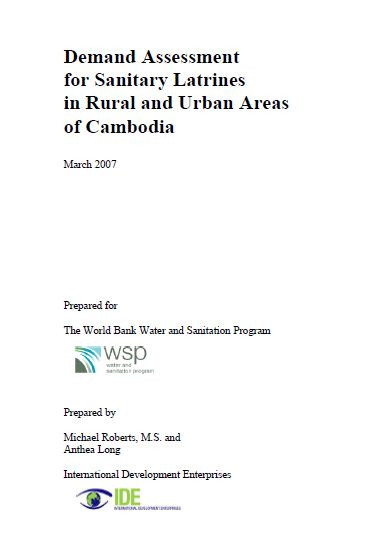Demand Assessment for Sanitary Latrines in Rural and Urban Areas of Cambodia
 |
Evaluation de la demande en assainissement – Cambodge
rapport Mar 2007 ; 109 pages
Aut.
Ed. WSP - Washington
Téléchargeable sous format: PdF
Téléchargeable chez l'éditeur
Abstract:
This report presents an assessment of demand for sanitary latrines in rural and urban areas of Cambodia. The objective of the study was to understand perceptions, desires, and practices regarding latrine use as a basis for designing interventions to stimulate demand.
Village and household level interviews and focus group discussions were conducted in three rural areas (Kandal, Svay Rieng and Siem Reap provinces), three urban areas (Phnom Penh, Svay Rieng, and Siem Reap municipalities), and two special case villages that had undertaken a process of Community-Led Total Sanitation. In total 41 villages and 939 households were surveyed, including both latrine owners and non-owners. In addition, six focus group discussions were conducted with a total of 44 participants including women and men, latrine owners and non-owners.
The results of the survey and focus group discussions provide information and insights relating to respondent demographic and economic profiles, water sources, current sanitation practices, perceptions about latrines, the decision to purchase a latrine, information channels, and the experience of disabled people with sanitation.
Among the survey population, 13% of rural households and 79% of urban households own a latrine.
Latrine coverage varied widely among villages, ranging from 0% to 100%, depending on environmental conditions, socio-economic factors, and the influence of NGO programs.
Unsurprisingly, latrine ownership was found to be more common among better-off households than in poorer households. Income and cost are key factors in a household’s decision to purchase a latrine, but they are not the only factors. A reluctance to build low-end latrines, a lack of attractive low-cost alternatives in that market, and the low rank of sanitation in household priorities are also important obstacles.
The survey results indicated a generally high level of awareness of hygiene issues. The majority of respondents could name basic sanitation messages and health/hygiene were in the top three perceived benefits of latrine ownership and top two motivations for latrine purchase.
Mots clefs: |
évaluation, impacts (CI) (DT) (OP) , latrine, toilettes (CI) (DT) (OP) , rural (CI) (DT) (OP) , urbain (CI) (DT) (OP) |
Pays concerné: |
Editeur/Diffuseur: |
|
WSP
-
Water and Sanitation Program - Washington - Etats Unis |
En cas de lien brisé, nous le mentionner à communication@pseau.org